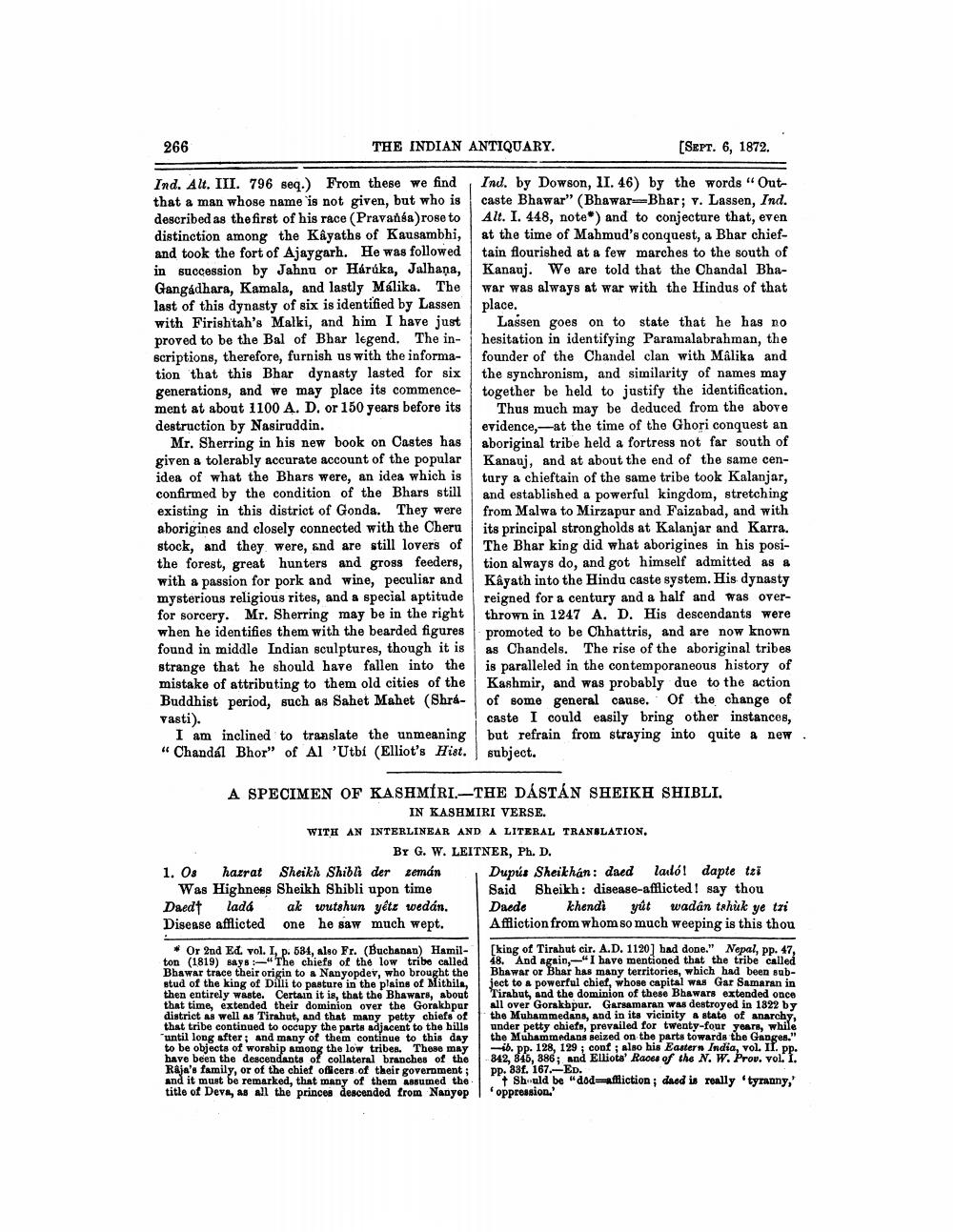________________
266
THE INDIAN ANTIQUARY.
(SEPT. 6, 1872.
Ind. Alt. III. 796 seq.) From these we find Ind. by Dowson, II. 46) by the words "Outthat a man whose name is not given, but who is caste Bhawar" (Bhawar-Bhar; v. Lassen, Ind. described as the first of his race (Pravansa)rose to Alt. I. 448, note*) and to conjecture that, even distinction among the Kâyaths of Kausambhi, at the time of Mahmud's conquest, a Bhar chiefand took the fort of Ajaygarh. He was followed tain flourished at a few marches to the south of in succession by Jahnu or Háráka, Jalhana, Kanauj. We are told that the Chandal BhaGangadhara, Kamala, and lastly Málika. The war was always at war with the Hindus of that last of this dynasty of six is identified by Lassen place. with Firishtah's Malki, and him I have just Lassen goes on to state that he has no proved to be the Bal of Bhar legend. The in- hesitation in identifying Paramalabrahman, the scriptions, therefore, furnish us with the informa- founder of the Chandel clan with Mâlika and tion that this Bhar dynasty lasted for six the synchronism, and similarity of names may generations, and we may place its commence- together be held to justify the identification. ment at about 1100 A. D. or 150 years before its Thus much may be deduced from the above destruction by Nasiruddin.
evidence,-at the time of the Ghori conquest an Mr. Sherring in his new book on Castes has aboriginal tribe held a fortress not far south of given a tolerably accurate account of the popular Kanauj, and at about the end of the same cenidea of what the Bhars were, an idea which is tury a chieftain of the same tribe took Kalanjar, confirmed by the condition of the Bhars still and established a powerful kingdom, stretching existing in this district of Gonda. They were from Malwa to Mirzapur and Faizabad, and with aborigines and closely connected with the Cheru its principal strongholds at Kalanjar and Karra. stock, and they were, and are still lovers of The Bhar king did what aborigines in his posithe forest, great hunters and gross feeders, tion always do, and got himself admitted as a with a passion for pork and wine, peculiar and Kâyath into the Hindu caste system. His dynasty mysterious religious rites, and a special aptitude reigned for a century and a half and was overfor sorcery. Mr. Sherring may be in the right thrown in 1247 A. D. His descendants were when he identifies them with the bearded figures promoted to be Chhattris, and are now known found in middle Indian sculptures, though it is as Chandels. The rise of the aboriginal tribes strange that he should have fallen into the is paralleled in the contemporaneous history of mistake of attributing to them old cities of the Kashmir, and was probably due to the action Buddhist period, such as Sahet Mahet (Shrá- of some general cause. Of the change of vasti).
caste I could easily bring other instances, I am inclined to translate the unmeaning | but refrain from straying into quite a new " Chandál Bhor" of Al 'Utbi (Elliot's Hist. subject.
A SPECIMEN OF KASHMIRI.-THE DÁSTÁN SHEIKH SHIBLI.
IN KASHMIRI VERSE. WITH AN INTERLINEAR AND A LITERAL TRANSLATION.
By G. W. LEITNER, Ph. D. 1. Os hazrat Sheikh Shibli der zemán Dupús Sheikhán: daed ladó! dapte tri
Was Highness Sheikh Shibli upon time Said Sheikh: disease-afflicted I say thou Daedt ladá ak wutshun yệtz wedán. Daede khendi yût wadân tshuk ye tri Disease afflicted one he saw much wept. Affliction from whom so much weeping is this thou
* Or and E vol. I. n. 684. algo Fr. (Buchanan) Hamil- fking of Tirahut cir. A.D. 1120] had done." Nepal, pp. 47, ton (1819) Bays "The chiefs of the low tribe called 48. And again,-"I have mentioned that the tribe called Bhawar trace their origin to a Nanyopdev, who brought the | Bhawar or Bhar has many territories, which had been substud of the king of Dilli to pasture in the plains of Mithila, ject to a powerful chief, whose capital WAS Gar Samaran in then entirely waste. Certain it is, that the Bhawars, about Tirabut, and the dominion of these Bhawars extended once that time, extended their dominion over the Gorakhpur all over Gorakhpur. Garsamaran was destroyed in 1822 by district as well as Tirahut, and that many petty chiefs of the Muhammedans, and in its vicinity & state of anarchy, that tribe continued to occupy the parts adjacent to the hills under petty chiefs, prevailed for twenty-four years, while until long after ; and many of them continue to this day the Muhammedans seized on the parts towards the Ganges." to be objects of worship among the low tribes. These may ib. pp. 128, 129; cont ; also his Eastern India, Vol. II. pp. have been the descendants of collateral branches of the 842, 845, 886; and Elliots' Races of the N. W. Prov. vol. 1. Raja's family, or of the chief officers of their government ; pp. 33f. 167.-ED. And it must be remarked, that many of them assumed the + sh uld be "dod=fliction; daed is really 'tyranny,' title of Deva, as all the princes descended from Nanyop oppression.'
Hodie family, or of the chief collateral brave These may




